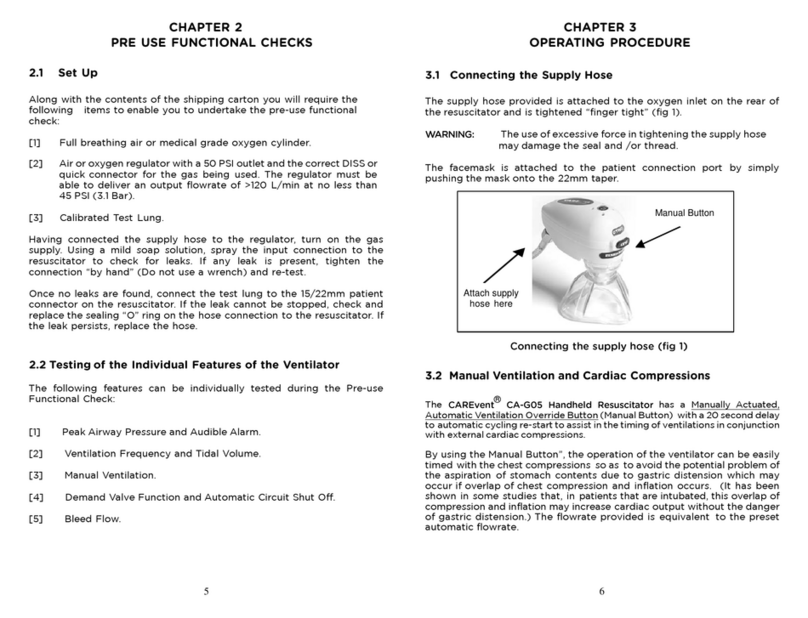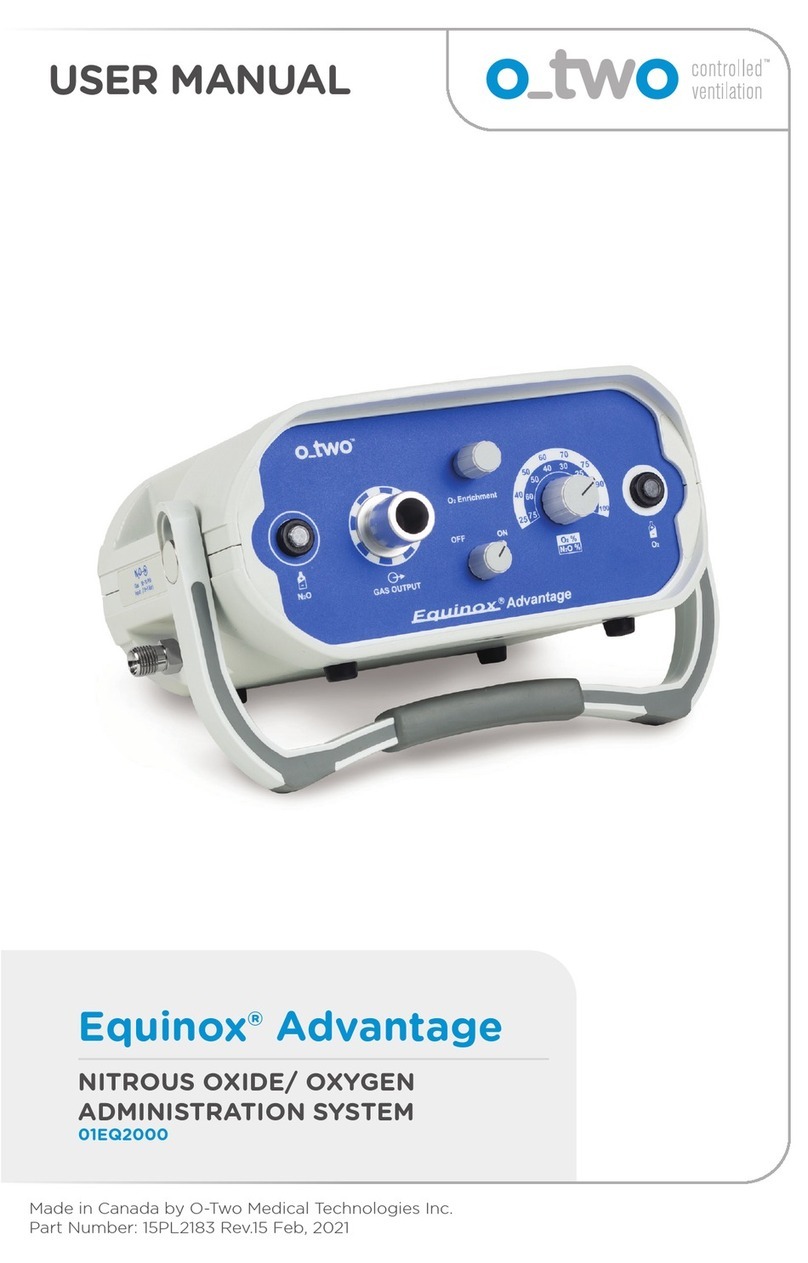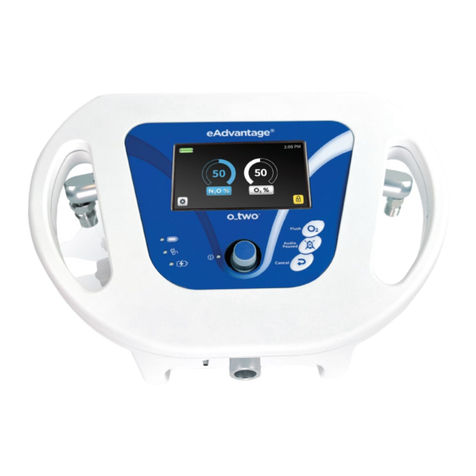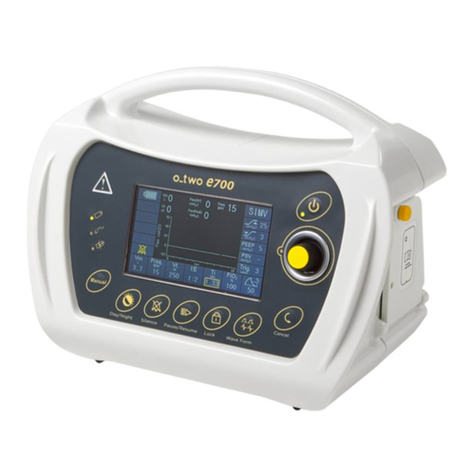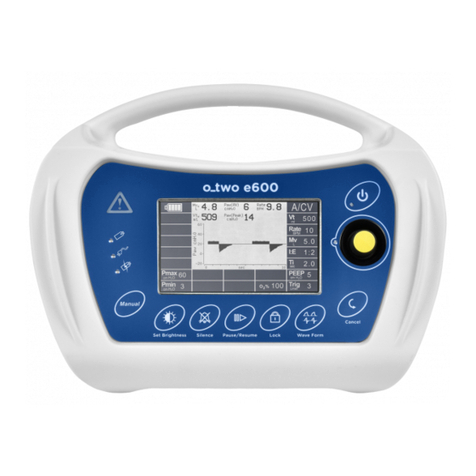O-Two 01MN1000 User manual

OPERATOR’S
MANUAL
VER2.0C21
Fingertip Pulse Oximeter
General Description
Hemoglobin saturation is a measurement of the number of oxygen molecules bound by each
molecule of hemoglobin expressed as a percentage. It is a very important physiological
parameter for the respiratory/circulatory system. Many respiratory diseases can result in
hemoglobin saturation being lowered in human blood. Moreover, the following factors can
also lead to problems in oxygen supply, so that human hemoglobin saturation might be
reduced: Automatic Organic Regulation Malfunction caused by Anesthesia, Postoperative
Trauma, injury caused by some medical examinations, illnesses etc. and may endanger the
patient’s life. Therefore, it is very important to know the Hemoglobin saturation of the patient
so that problems can be identified and rectified in a timely manner.
The Fingertip Pulse Oximeter is a small device with a low power consumption, simple to
operate and extremely portable. It is only necessary to apply the device to the patient’s finger
for the fingertip photoelectric sensor to measure and display the measured value of
hemoglobin saturation on the OLED screen. It has been proven in clinical experiments that it
is a precise and repeatable method of obtaining the patient’s hemoglobin saturation.
Measurement principle
Principle of the oximeter is as follows: An experience formula of data process is established
taking use of Lambert Beer Law according to Spectrum Absorption Characteristics of
Reductive hemoglobin(R Hb) and Oxyhemoglobin (O2 Hb) in glow and near-infrared zones.
The operating principle of the instrument is Photoelectric Oxyhemoglobin Inspection
Technology which is adopted in accordance with Capacity Pulse Scanning and Recording
Technology, so that two beams of different wavelength of lights (660nm glow and 940nm near
infrared light) can be focused onto the human nail tip through clamp-type finger sensor. Then
the measured signal can be obtained by a photosensitive element, information acquired
through which will be shown on two groups of LEDs on the display.
Diagram of Operation Principle
1. Red and Infrared-ray Emitter Tube
2. Red and Infrared-ray Receiver Tube
Precautions for use
1 Before use, carefully read the manual.
2 Do not use the pulse oximeter in an MRI or CT environment
3 Do not use the pulse oximeter in situations where alarms are required. The device has
no alarms.
4 Explosion hazard: Do not use the pulse oximeter in an explosive atmosphere.
5 The pulse oximeter is intended only as an adjunct in patient assessment. It must be
used in conjunction with other methods of assessing clinical signs and symptoms.
6 Check the pulse oximeter sensor application site frequently to determine the positioning
of the sensor and circulation and skin sensitivity of the patient.
7 Do not use adhesive tape to secure the pulse oximeter sensor to the patient. This may
cause inaccurate readings or skin blisters.
8 The pulse oximeter has no SpO2 alarms. It is not for continuous monitoring as indicated
by the symbol
9 Prolonged use, or the patient’s condition, may require changing the sensor site
periodically. Change sensor site and check skin integrity, circulatory status, and correct
alignment at least every 4 hours.
10 Do not autoclave, ethylene oxide sterilize, or immersing the sensors in liquids.
The following may cause inaccurate readings:
Significant levels of dysfunctional hemoglobins (such as carbonxy- hemoglobin or
methemoglobin)..
Intravascular dyes such as indocyanine green or methylene blue.
SpO2 measurements may be adversely affected in the presence of high ambient light or
direct sunlight (shield the sensor area and, if necessary cover the sensor).
Excessive patient movement or venous pulsations.
Placement of the sensor on an extremity with a blood pressure cuff, arterial catheter, or
intravascular line.
If the patient has hypotension, severe vasoconstriction, severe anemia, or hypothermia
If the patient is in cardiac arrest or is in shock
Fingernail polish or false fingernails may cause inaccurate SpO2 readings.
Product Properties
1 Operation of the product is simple and convenient
2 The product is small, lightweight (total weight is about 50g including batteries) and
convenient to carry.
3 Power consumption of the product is low and the two originally-equipped two AAA
batteries can be operated continuously for 30 hours.
4 Low voltage warning will be indicated in visual window when battery voltage is so low
that normal operation of the oximeter might be influenced.
5 The product will automatically be powered off when no signal is detected by the product
for longer than 8 seconds.
Product Operation Scope
The fingertip Oximeter can be used to measure Hemoglobin Saturation and heart rate
through the finger tip. The product is suitable for use in the home, in the field and in hospital
(including clinical use in internist/surgery, Anesthesia, pediatrics, intensive care and etc.) and
anywhere the measurement of hemoglobin saturation is required.
The product is not suitable to monitor the patient continuously.
Operation Instructions
1 Install the two AAAbatteries into battery compartment and replace the cover.
2 Grip the clamp as shown below
3 Insert the patient’s finger fully into the Oximeter and release the clamp.
4 Press the ON button on front panel once.
5 Read the data from display screen.
Note: When your finger is placed into the Oximeter, the nail surface must be facing upward.
Display Modes
The Oximeter has six (6) display modes. After the Oximeter is turned ON, each time you
press the power switch, the oximeter will switch to another display mode as follows:
1. 2. 3.
4. 5. 6.
When you press the power switch for more than one second, the brightness of the oximeter
will be changed by degrees, there are 10 levels of brightness; the default level is level four.
Note: Please use medical grade alcohol to clean the rubber inside of the Oximeter between
patients and clean the test finger using alcohol before and after each test. (The rubber used is
of a medical grade and has no toxins and is not harmful to the skin).
Brief Description of Front Panel
Low power indicator
SpO2 waveform
Note: The heart rate bargraph display corresponds with the pulse rate.
Items included
1. Finger Tip Pulse Oximeter –Qty 1
2. Lanyard - Qty 1
3. Batteries 1.5V “AAA” – Qty. 2
4. Carrying case –Qty 1
5. User manual –Qty 1
Pulse Rate
Pulse Rate Bargraph
SpO2
Power
Switch
0120
Model #: 01MN1000

Battery Installation
1. Install the two AAA batteries into battery compartment. Observe the correct polarity as
shown on the device.
2. Push the battery cover horizontally along the arrow shown as below:
Notes: Please remove the batteries if the Oximeter is not to be used for a long time.
Lanyard Installation
1. Thread the thinner end of the lanyard through the lanyard hole.
2. Thread the thicker end of the lanyard through the threaded thinner end and pull tight.
Maintenance and Storage
1. Replace the batteries immediately when the low voltage lamp is lit.
2. Clean surface of the fingertip oximeter before it is used.
3. Remove the batteries inside the battery compartment if the Oximeter will not be
operatedfor a long time.
4. It is best to store the product in ambient temperatures –10 - +40℃(14 - +104℉) and
humidity is 10%-80%
5. It is recommended that the product should be kept in a dry environment.. A wet ambient
environment may affect its lifetime and may damage the product.
6. Follow local laws and recycling instructions regarding disposal or recycling of the device
and device components, including batteries.
Detailed descriptions of product functions:
1. Display Type: OLED display
2. SpO2:
Measurement range: 70-99%
Accuracy:±2% on the stage of 80%-99%; ±3% on the stage of 70%-80%;
3. Pulse Rate:
Measure range:30-235 BPM
Accuracy:±2 BPM or ±2%(larger)
Pulse Intensity: Bargraph Indicator
4. Power Requirements:
Two AAA alkaline Batteries.
Power consumption: Less than 40mA
Battery Life:
TwoAAA 1.5V, 600mAh alkaline batteries up to 30 hours.
Low power indication:
5. Dimensions:
Length: 58mm
Width: 32mm
Height: 34mm
Weight: 50g (including two AAAbatteries)
6. Environment Requirements:
Operation Temperature: 5-40℃
Storage Temperature: -10-40℃
Ambient Temperature: 15%-80% in operation
10%-80% in storage
7. Declaration:
EMC of this product comply with IEC60601-1-2 standard
The materials which user can come into contact with are non-toxic and have
no affect on body on tissues. The device and materials of manufacture
comply with ISO10993-1,-5,-10.
8. Interference Resistance Capacity against Ambient Light: Device works normally in
mixed noise produced by BIO-TEK INDEX Pulse Oximeter tester.
Guidance and manufacture’s declaration – electromagnetic emissions-
for all EQUIPMENT and SYSTEMS
Guidance and manufacture’s declaration – electromagnetic emission
The Pulse Oximeter is intended for use in the electromagnetic environment specified below. The customer of
the user of the Pulse Oximeter should assure that it is used in such and environment.
Emission test
Compliance
Electromagnetic environment –guidance
RF emissions
CISPR 11
Group 1
The Pulse Oximeter uses RF energy only for its
internal function. Therefore, its RF emissions are
very low and are not likely to cause any
interference in nearby electronic equipment.
RF emission
CISPR 11
Class B
The Pulse Oximeter is suitable for use in all
establishments, including domestic establishments
and those directly connected to the public
low-voltage power supply network that supplies
buildings used for domestic purposes.
Trouble Shooting Chart
Problems
Possible reason
Solution
SpO2 or PR cannot
be read
1. Finger is not inserted correctly
2. Patient’s Oxyhemoglobin value is too
low to be measured
1. Re-insert finger ensuring that the nail is upwards
2. If the problem persists contact the manufacturer and
use an alternate method of measuring SpO2
SpO2 or PR is shown
unstably
1. Finger might not be inserted fully
2. Finger is trembling or patient’s body
is moving
1. Retry by plugging the finger
2. Try not to move
The Oximeter can
not be powered on
1. Device will not turn ON
2. Battery power may be inadequate
3. Batteries may not be installed
4. Batteries may be installed incorrectly
5. The Oximeter may be damaged
1. Re-insert finger ensuring that the nail is upwards
2. Replace the batteries
3. Insert the batteries
4. Replace the batteries
5. If the problem persists contact the manufacturer
Indication lamps are
suddenly off
1. The product is automatically powered
off when no signal is detected longer
than 8 seconds
2. Power level of the batteries low
1. Normal
2. Replace the batteries
“Error3” or
“Error4” Displayed
on screen
1 .Low power
2. Receiving tube being shielded or
damaged together with broken
connector.
3. Mechanical Misplace for
receive-emission tube
4. Amp circuit malfunction.
1. Replace the batteries
2. Contact the manufacturer
3. Contact the manufacturer
4. Contact the manufacturer
“Error7” displayed on
screen
1. Low power
2. Emission tube damaged.
3. Current control circuit malfunction.
1 Replace the batteries
2 Contact the manufacturer
3Contact the manufacturer
Symbol Definitions
Symbol
Definition
The equipment type is BF
Refer to user manual before application
SpO2%
Hemoglobin saturation
Heart rate (BPM)
Low power indication
Serial No.
Not for continuous monitoring
IPX1
Drip-proof
Model No.
O-Two Medical Technologies Inc.
“Innovation in Resuscitation”
7575 Kimbel Street, Mississauga, Ontario, Canada, L5S 1C8
Tel: +1 905 677 9410 Fax: +1 905 677 2035
Other O-Two Medical Equipment manuals
Popular Medical Equipment manuals by other brands

Getinge
Getinge Arjohuntleigh Nimbus 3 Professional Instructions for use

Mettler Electronics
Mettler Electronics Sonicator 730 Maintenance manual

Pressalit Care
Pressalit Care R1100 Mounting instruction

Denas MS
Denas MS DENAS-T operating manual

bort medical
bort medical ActiveColor quick guide

AccuVein
AccuVein AV400 user manual
